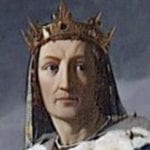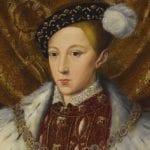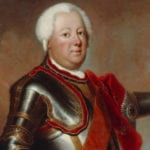 Music
Music  Music
Music  History
History 10 Less Than Jolly Events That Occurred on December 25
 Weird Stuff
Weird Stuff 10 Funny Ways That Researchers Overthink Christmas
 Politics
Politics 10 Political Scandals That Sent Crowds Into the Streets
 Weird Stuff
Weird Stuff Ten Bizarre Facts About The Doge Meme
 Our World
Our World 10 Ways Your Christmas Tree Is More Lit Than You Think
 Movies and TV
Movies and TV The 10 Coolest Stars to Set Sail on The Love Boat
 History
History 10 Things You Didn’t Know About the American National Anthem
 Technology
Technology Top 10 Everyday Tech Buzzwords That Hide a Darker Past
 Humans
Humans 10 Everyday Human Behaviors That Are Actually Survival Instincts
 Music
Music 10 Surprising Origin Stories of Your Favorite Holiday Songs
 History
History 10 Less Than Jolly Events That Occurred on December 25
 Weird Stuff
Weird Stuff 10 Funny Ways That Researchers Overthink Christmas
Who's Behind Listverse?

Jamie Frater
Head Editor
Jamie founded Listverse due to an insatiable desire to share fascinating, obscure, and bizarre facts. He has been a guest speaker on numerous national radio and television stations and is a five time published author.
More About Us Politics
Politics 10 Political Scandals That Sent Crowds Into the Streets
 Weird Stuff
Weird Stuff Ten Bizarre Facts About The Doge Meme
 Our World
Our World 10 Ways Your Christmas Tree Is More Lit Than You Think
 Movies and TV
Movies and TV The 10 Coolest Stars to Set Sail on The Love Boat
 History
History 10 Things You Didn’t Know About the American National Anthem
 Technology
Technology Top 10 Everyday Tech Buzzwords That Hide a Darker Past
 Humans
Humans 10 Everyday Human Behaviors That Are Actually Survival Instincts
10 Viking Kings And Their Epic Deeds
For the Vikings, reputation was the most important thing in life. In their eyes, a person’s deeds were the only thing that survived them long after they were gone, so they loved to celebrate the actions of their ancestors and friends while trying to make a name for themselves personally, whether that be by exploring, conquering, raiding, or patronizing the people who wrote the songs: the skalds.
As such, we thought that a list retelling the grandest deeds of the Viking kings would be a great way to celebrate them (and to bring some entertainment value). After all, it’s what they would have wanted. Here, we learn about ten Viking kings and their epic deeds.
10 Harald Fairhair, The First King Of Norway
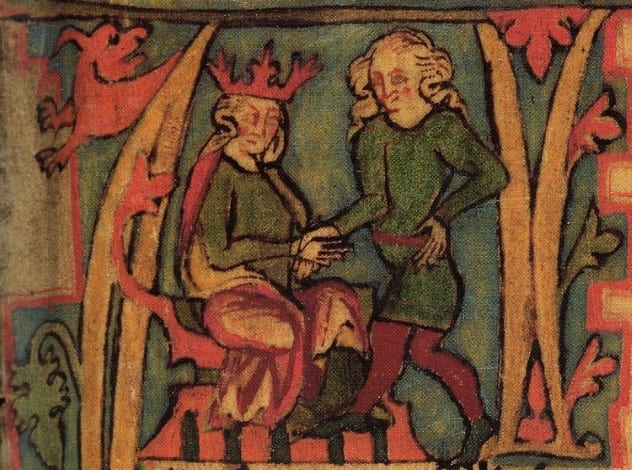
Any list covering the greatest achievements of the Viking kings wouldn’t be complete without mentioning Harald Fairhair.[1] Despite his pseudo-mythical status, most historians now believe that Fairhair did exist but that his exploits were probably not as dramatic as the sagas make them out to be. He was likely a petty king in Southwest Norway who was able to subjugate his neighbors and rule over a large portion of what is now modern Norway.
According to the sagas, the Battle of Hafrsfjord was a crucial moment for Harald’s young kingdom. Dated to sometime between 870 and 900, it was a large battle by contemporary standards and involved many of the petty kings of Norway. The only king mentioned in a source from the time of the battle was Kjovte the Rich, who supposedly fled after Harald’s victory, leaving many of his men to die. The place believed to be the site of the battle is now marked by the Swords in Rock, three 10-meter-tall (33 ft) monuments which represent Harald and the kings he defeated.
Following Hafrsfjord, Harald established the most influential power bloc in Norway, from which he and his successors were able to exert pressure on their neighbors and ultimately form the Kingdom of Norway, which exists to this day.
9 Rurik, The Founder Of Russia
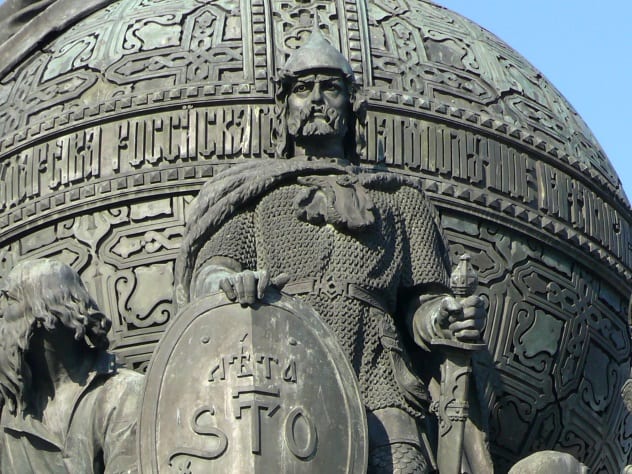
The Rurikid dynasty was one of the longest-reigning lineages in human history: They were kings in Russia from the depths of the Viking age to the reign of Ivan the Terrible centuries later. And it was founded by a Viking.[2]
The Primary Chronicle of Russia, which was assembled in 1113 from a collection of earlier pieces, tells us the story of Russia’s beginnings. According to the Chronicle, the Slavic people who lived in modern-day Ukraine and Russia invited Rurik and his two brothers to rule over them, thinking they would bring law and order to the tribes. They clearly accepted, but Rurik’s brothers died shortly after, leaving him to rule alone.
In the past, some historians questioned the authenticity of the story told in the Chronicle, but most now accept it as fact. Rurik was a Varangian, warriors who served the Byzantine emperor as their personal bodyguard (and who were nearly all Norse), so he would have been well-respected. There is also evidence of significant Viking influence in the area of modern-day Russia and Ukraine: When Harald Hardrada lost the Battle of Stiklestad in 1030, he fled to stay with family in Kiev. The Vikings also had trade routes across Europe, from Baghdad and beyond to the coast of Spain, so it’s not unreasonable to expect the warriors and traders who crossed from Scandinavia to Greece and the Middle East to settle down along the way. Odinist symbols and Scandinavian blacksmithing tools dating back to the Viking age, among other items, have been found in Lagoda and Novgorod, which suggests there was at least some Norse influence in the region, and the Arab traveler Ahmad ibn Fadlan encountered Viking tribes while journeying through the lands of the Rus.
Either way, Rurik was a member of the Norse Varangian Guard who established a small kingdom in modern-day Russia, and his descendants (who were raised as Slavs) continued his legacy, remaining kings and princes in the area until 1612, which is no mean feat.
8 Eric Bloodaxe, The Last King Of Northumbria

Most of us have heard of Eric Bloodaxe, the last Viking king of Northumbria. Beyond his name, however, most of us know little about him, but we assume he must’ve been a great Viking to have earned the nickname “Bloodaxe.”
In fact, the name more likely comes from the connotation of “blood” meaning “family” or “brotherhood,” so an equally accurate translation could be “brotheraxe” or “familyaxe.” This nickname makes sense when we learn that he killed five of his brothers in order to win the throne of Norway![3]
He only ruled in Scandinavia for a short time before he was deposed by his last remaining brother, fleeing to Britain without a fight. Why he gave up his kingdom so easily we’ll probably never know, but it might have been because he saw a brighter future for himself in the British Isles. If he did, he wasn’t wrong, because he was easily able to assert control over the kingdom of Northumbria and rule it undisputed until his death in 954.
7 Sictric Caech And The Battle Of Islandbridge
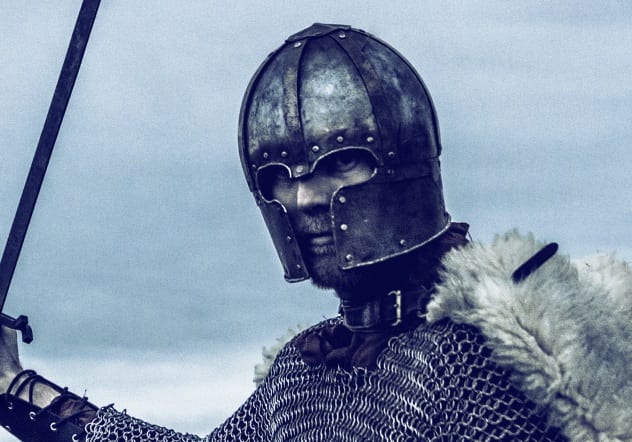
The Vikings have a long history in Ireland—the city of Dublin was actually founded by Vikings to serve as a commercial center for their slave trade. Their actual influence in Inner Ireland ebbed and flowed over the years, and in 902, they were forced out of Dublin by a united army of several Irish kings. Sictric Caech was one of these Vikings.
At first, he went on to rule a small kingdom in the Danelaw, but the Anglo-Saxons had conquered most of the Danelaw by 918 and driven most of the Vikings out of England. Following this, Sictric returned to Ireland, this time at the head of an army. They won some early battles with the Irish kings and staked out a small claim for themselves, but the war was far from conclusive.
Things came to a head at the Battle of Islandbridge in 919.[4] The Irish king Niall Glundub led a coalition of Northern Irish kings to drive the Vikings back out. Sictric and his army met them on the way. The battle was a crushing victory for Sictric, with five Irish kings and the High King of Ireland himself meeting their ends in the bloodbath. Sictric reigned as the undisputed king of Dublin for another three years, after which he seems to have returned to England by his own choice.
6 Sweyn Forkbeard And The Conquest Of England

Sweyn Forkbeard became the first Viking king of all England in 1013, though he only reigned for five weeks before his death—not long enough to even be officially crowned.[5]
But it is the reasoning behind his invasion that makes him a truly respectable Viking king.
By Sweyn’s time, the Vikings had lived in England for nearly 200 years but had never managed to conquer the entire kingdom. They ruled the northeastern half of England as the Danelaw until the end of Eric Bloodaxe’s reign in 954, when they were driven out. People of Viking descent continued to live in England, however, and the Viking kings across the sea continued to have an interest in their people.
So when the English king ordered the mass slaughter of Vikings living in England in 1002, Sweyn planned his revenge. While he’d been raiding the English coast on and off for a decade or so, now he mustered an invasion force. They landed in 1003, causing widespread destruction and pillaging much of the country in revenge. Ethelred the Unready was forced to pay Sweyn a ludicrous amount of silver to stop the latter from burning his kingdom.
But ten years later, Sweyn was back, this time with an army big enough to seize England. They landed in Kent and rampaged through the countryside, soon reaching London. The English earls, fearing another drawn-out war and already skeptical of their own king, drove Ethelred into exile and declared Sweyn king of England.
While Sweyn’s reign didn’t last long, it did pave the way for another Viking invasion, this one much more permanent.
5 King Cnut And The North Sea Empire
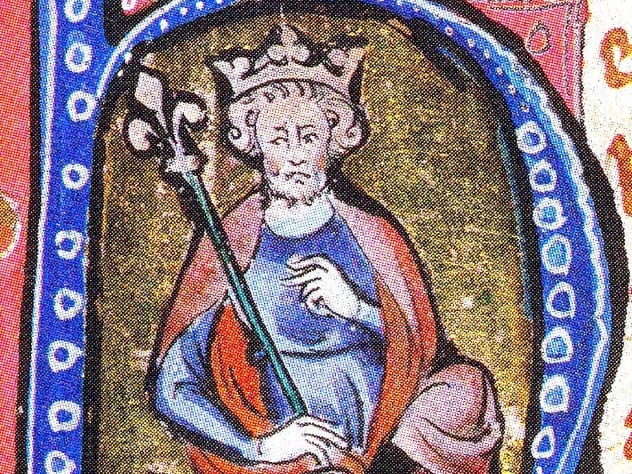
With Sweyn’s death, his son Cnut was left in charge of his father’s army in England. The English lords, however, chose to bring Ethelred back, and Cnut fled to Denmark.
He immediately set about raising a larger army and even asked his brother (and rival), the king of Denmark, for warriors to help him. Poles, Swedes, and Norwegians flocked to his banner, drawn by the promise of loot. Cnut landed in Wessex in 1015 at the head of 10,000 men and laid waste to the country, conquering from Cornwall to Northumbria.[6]
But London remained defiant under the leadership of the newly chosen English king, Edmund Ironside. The armies of the two kings met at the Battle of Assandun (usually accepted to be modern-day Ashington), where Cnut won a close-fought engagement. English resistance crumbled.
By 1018, Cnut was also king of Denmark following the death of his brother, and he finally conquered Norway in 1028, after years of conflict with various Scandinavian lords. Though they’d originally fought against him, the English were remarkably loyal to Cnut during his reign; he spent much of his 20-year tenure putting down rebellions or fighting enemies in his homeland, leaving England to be governed by his allies, and by his death, nearly all the men on his council were English.
Cnut became one of the most powerful kings in Europe, meeting with the pope and the emperor of Germany on several occasions and fostering economic links between his three kingdoms. While his empire broke apart on his death, he seems to have made little effort in his life to see it continue, abandoning Norway to rebels in the final years of his reign and leaving Denmark to his son Harthacnut and England to his other son, Harold Harefoot. The union of the three kingdoms made Cnut the most powerful king in Europe at the time, however, and his descendants would repeatedly try (and fail) to recreate his successes.
4 Harald Bluetooth’s Ring Fortresses
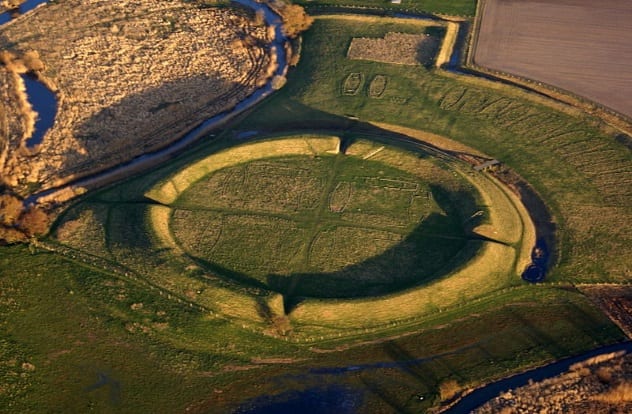
Before Cnut and Sweyn, however, someone had to turn Denmark into the strong, centralized state that it had to be to go toe-to-toe with England. This king was Harald Bluetooth, Sweyn’s father and long-reigning king of Denmark.
Not all Viking strength came from conquest. Over the course of his 30-year reign, Harald transformed Denmark from a political backwater into a strong medieval state. Harald’s plans for creating a centralized government are best summed up by his Trelleborg ring forts: fortresses built across Danish territory, centered at the fort at Aarhus, in the geographical center of the region. Each one was built to exact standards, with four gates (each facing one of the compass points), a tall wall and ditch around the outside, and an open courtyard with administrative buildings in the middle.[7] These would have served as both tax collection points and places for Danish kings to muster their armies, laying the groundwork for the conquests of his son and grandson.
The fortresses were all built in locations that were close to the sea, but far enough from it to be safe from sea raids, and alongside Viking land routes, where they would have been both well-connected and highly visible, a powerful symbol of the king’s authority. Their sites seem to have been meticulously chosen to efficiently defend and control the people of Denmark, which was no doubt at the forefront of Bluetooth’s mind after the history of wars in Norway and his father’s difficult reign.
Unfortunately for him, the ultimate threat came from within, when his son Sweyn forcibly deposed him.
3 Harald Hardrada And The Destruction Of Heidaby
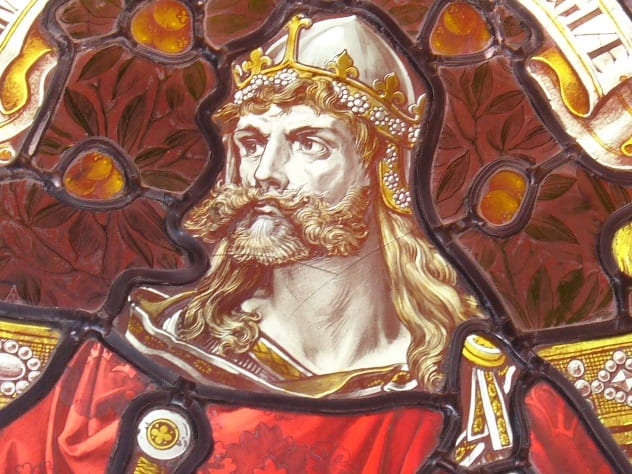
Harald Hardrada (Hard-Ruler) is famous in history for being one of the last Viking kings and for unsuccessfully trying to seize the throne of England by force—losing the crucial Battle of Stamford Bridge in 1066 to Harold Godwinson, which paved the way for William the Conqueror’s ultimate victory.[8]
This battle, however, came at the end of a long and distinguished Viking career which had taken Harald all around the known world, from Norway to Sicily and Palestine, over the course of 30 years. Perhaps his greatest (or worst) feat was the destruction of Heidaby. Heidaby was a Norse town at the base of Jutland with trade connections across the northern world: It rose to prominence in the late 700s and became the most important town in the Western Viking world.
Harald, who was king of Norway at the time, was trying to subdue Denmark and add it to his realm, and he sought to weaken Denmark by raiding its coast. His campaign took him to Heidaby, which refused to willingly submit to him. In response, he drove burning ships into the harbor, setting it alight. The flames spread rapidly across the whole town. Snorri Sturlason writes that Harald’s men sang: “All Heidaby is burned down! Strangers will ask where stood the town. In our wild humor up it blazed, and Svein looks round him all amazed,” (albeit in Old Norse, of course).
The town of Heidaby never recovered and fell from importance. It was finally brought to an end by a Slavic raid in 1066, which wiped it off the map for good.
2 Sweyn II Of Denmark And The Last Viking Invasion Of England
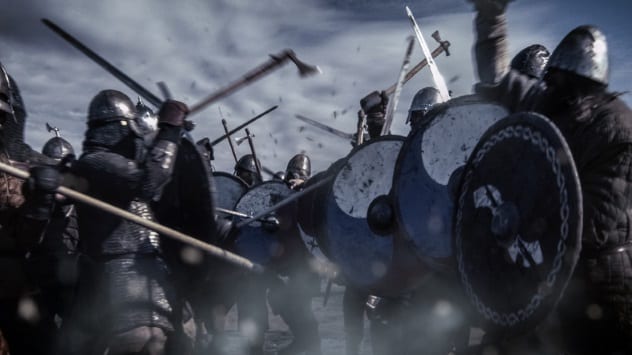
The death of Harald Hardrada at the Battle of Stamford Bridge in 1066 is usually considered the end of the Viking age, and many people call Hardrada the last Viking king. The truth is hardly ever that simple, however.
Following William’s conquest of England, the Godwin family were deposed but not defeated. They continued to harass the new kingdom from the sea, and in 1069, Sweyn II of Denmark decided to back one of the Anglo-Saxon pretenders.[9] Why he did so is not 100-percent clear, but it may have been related to his lifelong rivalry with Hardrada. After all, Hardrada had died trying to seize England, so what better way to one-up your rival once and for all than to succeed where he failed?
Sweyn was successful, too, seizing a good portion of Northern England and holding it from William, but in true Viking fashion, he was ready to seize the advantage and turned on his Anglo-Saxon ally when William offered to pay him a large sum of money to go back to Denmark; without Sweyn’s support, the rebellion crumbled, and England remained Norman. The Vikings were never able to conquer England again.
1 Olaf III, The Last Viking King
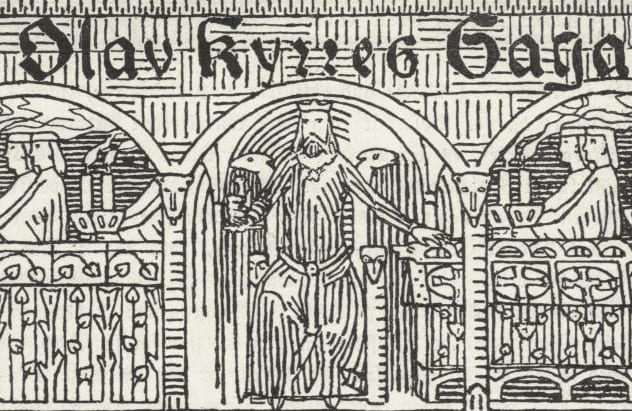
This brings us to our last epic Viking king, and the man who some consider the real last Viking king, Olaf III—who was known as Olaf the Peaceful. While not as warlike or bloodthirsty as the other Viking leaders on this list, Olaf was a great politician who effectively created the modern state of Norway.[10]
Olaf may have been swayed by his involvement in his father Harald’s invasion of England in 1066. While he was not present at the battle where his father died—he remained with the ships—he was a great proponent of peace during his reign, and Norway didn’t go to war for a quarter of a century, putting him at stark contrast with his father, who was always either adventuring or trying to expand his domains.
Olaf deliberately transformed Norway into a more “normal” continental European country: he drew the Norwegian church into line with the pope’s teachings and reorganized the dioceses of Norway, and it’s also believed he was the first Viking king who learned to read. He built a European-style court around himself, introducing medieval aristocratic culture to Norway. During his reign, urban growth flourished, and the town of Bergen was founded, which went on to become the capital of medieval Norway. Many Norwegian laws were officially put down in writing for the first time in Olaf’s reign.
Read more about the ever-memorable Vikings on 10 Forgotten Vikings Who Terrorized The Dark Ages and 10 Interesting Viking Rituals.






